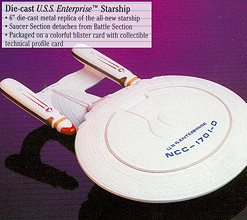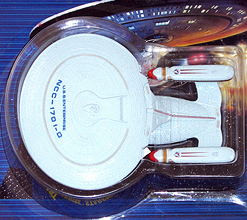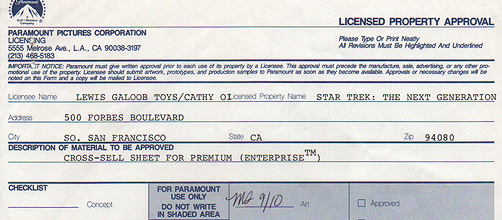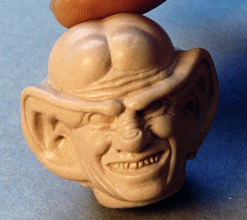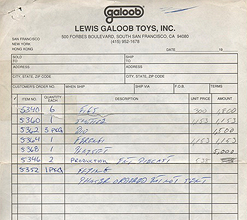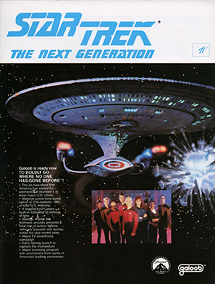 As Star Trek: The Next Generation was ramping up production, San Francisco-based Lewis Galoob Toys, Inc., was awarded the merchandising license for the revived series, which allowed Galoob to become the sole source of TNG-based action figure and accessory toys at the start of the series.
As Star Trek: The Next Generation was ramping up production, San Francisco-based Lewis Galoob Toys, Inc., was awarded the merchandising license for the revived series, which allowed Galoob to become the sole source of TNG-based action figure and accessory toys at the start of the series.
Though the Galoob line was unfortunately a commercial failure, cut down after the first year of production – only fourteen of the nearly thirty planned products ever made it to store shelves.
Our initial research online led to several partial accounts of these toys, most of which have conflicting (or flat-out speculative) information included in the reports, but we wanted the real story behind the Galoob line: to learn about how each item was decided upon, and the truth behind all the cancelled products which to this day have only appeared in grainy photographs or low-resolution images on the Internet… and some of which have never appeared online at all, even in a passing mention.
This series has been in the works for the past four months, and has consisted of dozens of emails, photographs, message board postings, and phone calls to bring a full and accurate account of Galoob’s products to Trek fans, just in time for the twenty-fifth anniversary of its release. Helping us in this task are two former Galoob employees: illustrator Jim Fong, and modelmaker Bob DiGiacomo (occasionally seen online as “TOYSTUF”), both of which played instrumental roles in getting the Galoob Next Generation line to store shelves.
The majority of images included in this multi-part series were provided by Jim and Bob, who both have many fascinating photos and documents in their archives. We must also credit Paul Combs of MegoCollector.com and Enrico from StarTrek-Collection.nl, both of whom provided several vital images for use in this project. Thanks a lot, guys!
TrekCore: What was your role at Galoob, and how did you get involved with the Next Generation line of toys?
Jim Fong: Around 1985, I was hired by Galoob as a senior designer to design boys’ toys. I had a background in more traditional industrial design; before Galoob, I worked for various large corporations and consulting firms in Silicon Valley.
Bob DiGiacomo: I had worked at Ideal Toys many years ago. When one of the principals from Ideal – Saul Jodel, who did a lot of Ideal’s marketing work – moved out to work at Galoob in California, he brought in several former Ideal people like me when the company started to show some promise. At the time, Galoob was looking to go more promotional, and I was hired to start up the model shop in San Francisco. Before I got there, they probably only had a hammer, a screwdriver, and a couple of cans of spray paint.
Jim Fong: When we got the Galoob license, I was thrilled – the 1966 Star Trek show was such a big part of my life. I was too young to fully comprehend all the nuances of the series when it originally aired, but when the show went into syndication, I was older and certainly understood all of the show’s political and social messages.
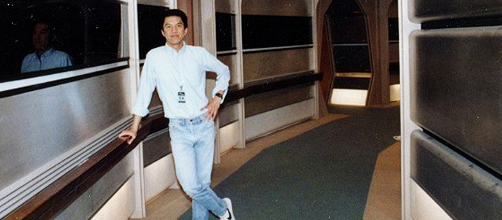 Jim Fong explores the corridors of the Enterprise-D during “Farpoint.”
Jim Fong explores the corridors of the Enterprise-D during “Farpoint.”
(Photo: Jim Fong)
I had a boss who knew that I was a Trek fan, so he sent me down to Paramount to meet with the show’s art department, to visit the Next Generation sets, and to take reference photos for use in our product design – all before the show began to air on television.
Visiting the studio was a very exciting experience! I had a chance to walk around all of the sets, guided by a Paramount representative and accompanied by an electrician who activated all of the lighting so we could see the bridge and transporter room so I could take a close look at all of the on-set graphics and consoles.
They were filming “Encounter at Farpoint” while I was on the lot – I even got to see Michael Bell taking a break, eating a candy bar in his full Groppler Zorn wig and costume. Even as an alien, there were still some earthly delights!
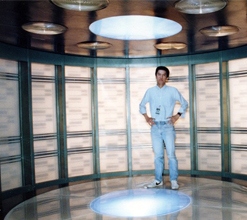 |
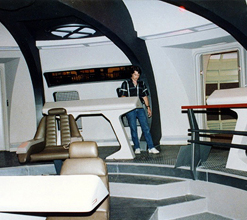 |
| Visiting the Transporter Room and Battle Bridge sets. (Photos: Jim Fong) |
|
I remember making the Paramount rep nervous when we visited the transporter room. I was like a kid in a candy store, and I just needed to step up and try to beam back to San Francisco… but if I caused any damage, he would have been responsible! I convinced him to let me get on the transporter and take a photo, and I discovered that it wasn’t quite as sturdy as I expected – the floor was made of a large plexiglass sheet, and there was a lot of flexibility to it. The platform squeaked in discomfort as I walked across it, but it was great to be able to stand there and be part of history.
The rest of the sets were pretty amazing to see as well. I got to sit in the captain’s chair and feel what it was like to be in command of a starship, and really felt that everything was built with extreme quality – high-quality construction, excellent materials… not just cardboard and scotch tape.
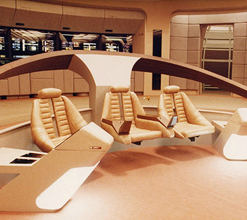 |
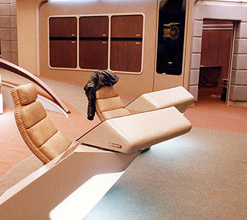 |
| The forward section of the Bridge set, and a view of a cluttered Ready Room. (Photos: Jim Fong) |
|
In addition to the Paramount lot, I also traveled to Industrial Light & Magic, where the six-foot Enterprise-D model was being prepared for use in the show’s pilot episode. That visit was just as exciting, since I love to build models myself, and they had many of the filming models from my favorite movies on display.
The Enterprise model was beautifully crafted, and it looked great – the team at ILM had it mounted for motion-control work, and it looked like they were working on some flyby test footage. I also got to meet Greg Jein, one of Trek’s number-one fans, who was working on the models at the time.
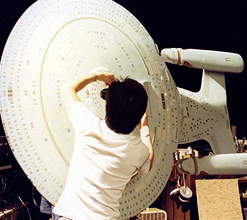 |
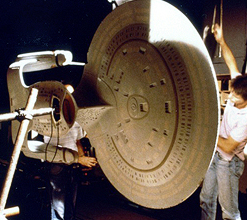 |
| The six-foot Enterprise-D model mounted for motion-control filming at ILM. (Photos: Jim Fong) |
|
It was an honor and a privilege for me to be there on the set, and to work on a project like Trek which I’ve loved since I was a kid. Galoob was not a big company, and we didn’t have the clout or scale of some of the larger competitors like Mattel and Hasbro – but we were all thrilled when we got the Trek license, and we made sure to do the best we could with the very limited resources available to us.
TrekCore: From a design perspective, what would you look for when you examined the Trek stages and props in person? How did you translate them from full-size sets and models into the final Galoob products?
Jim Fong: I worked hard to bring a sense of authenticity to the toys, to match the set or prop to the toy in exact detail and size. I would have taken the actual thing and shrunk it down to toy-sized dimensions if I could, but as an industrial designer, I am torn between keeping it authentic to the original while still maintaining a toy-style design to the product.
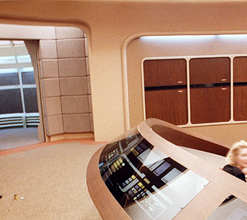 |
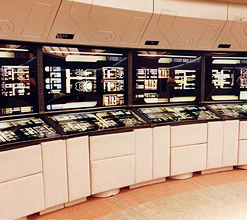 |
| A look at the aft section of the Bridge set. Note the rarely-seen “Propulsion Ops” and “Emergency Manual Control” consoles, removed after Season One. (Photos: Jim Fong) |
|
On the sets, I would look for whatever could offer the best play features and visual impact – so that meant that the most action would be on the bridge and the transporter room, a planet surface would be good for confrontations with hostile aliens, etc. I also made sure to have the bridge, hallway, and engineering consoles lit up so that we could get the label art correct.
TrekCore: Could you talk a bit about the design process, and how things worked with Galoob’s manufacturer in China?
Jim Fong: For the character-based figures, I took a few reference photos while visiting the sets, but Paramount ended up supplying us better pictures of the actors in their uniforms for our use. These shots were sent to our sculptors so that they could be as accurate as possible when they would do their work.
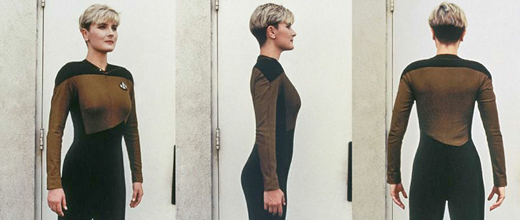 Reference photos of Denise Crosby. (via Star Trek: TNG 365)
Reference photos of Denise Crosby. (via Star Trek: TNG 365)
Close-up photos were very useful, because it allowed the artists to focus on the faces to match the end product to the live actor – but obviously, the sculpt likeness is only as good as the sculptor, so a bad artist can still get the look very wrong even when they have the best photos to work from. Today’s toys are much more accurate to the actor they’re modeled from, due to digital scanning processes which reduce the need for traditional sculpting work.
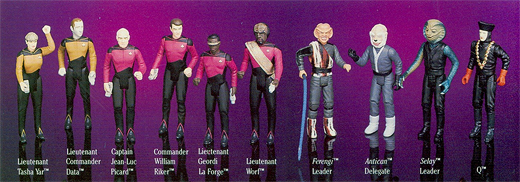 The action figures: the six Starfleet characters were released in May 1988;
The action figures: the six Starfleet characters were released in May 1988;
the aliens followed in August. (Catalog image: Paul Combs)
Once the characters were sculpted and casting molds were made, production samples would be hand-painted and FedEx’d to us for review. Those samples would also be provided to Paramount for their approval, and additional sets would be sent to our sales team.
TrekCore: How much did the domestic model shop get involved at this point?
Bob DiGiacomo: We would do some R&D stuff in-house, and we’d bounce around ideas that had been submitted by different inventors, but most of the model work was done in Hong Kong – the sales samples and so forth. There were things going in and out to our Galco subsidiary in Hong Kong like every day, so if there was something that we could do to avoid a shipment – change a color, or adjust some mechanism – we’d do it locally.
What we mostly did was support the sales team. I would do all the television commercials and toy shows, and we’d have special showings for bigger clients.
TrekCore: For the major retailers?
Bob DiGiacomo: Yes, the retailers. We would travel to their offices and show them the different toy lines we were offering. Galoob was still pretty small back then, and we hadn’t really proved ourselves to the industry yet – so we had a lot of running around to do!
TrekCore: What about the other toys – the Galileo shuttlecraft, the Ferengi fighter, the Phaser, and the die-cast Enterprise?
Jim Fong: Well, for the non-figure toys, we had to create a rendering of how we envisioned the final products, with play features. Usually, it was just a general marker sketch or line drawing. If these were approved by both Galoob management and Paramount, we’d move on to do more complete illustrations called “control drawings”.
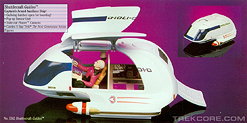 |
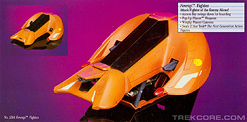 |
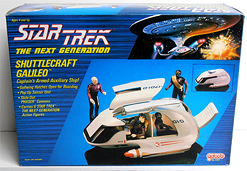 |
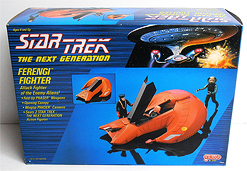 |
| Dealer catalog listings for the shuttlecraft Galileo and Ferengi Fighter play models, along with images of the final retail releases. (Catalog images: Paul Combs) | |
You have to keep in mind that this was being done before computers were part of the process, so everything was completed by hand. The control drawings were technical drawings with different views of the toys and their play features, the number of parts involved, component sizes, etc. Some people would put in fully-measured dimensions of each part of the toy; others would just label the drawings with a general height, width, and depth and let the crew in Hong Kong deal with the rest.
When everything was ready, we’d send a “turnover package” to the Hong Kong office, which included the control drawings, reference photos, cost projections, production numbers, and color specifications and paint guidelines – along with a complete written description of how the toy was expected to function and any additional business verbiage needed to complete the package.
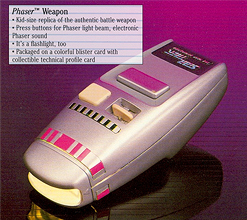 |
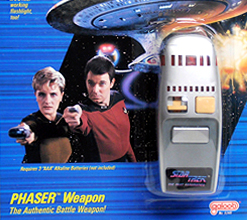 |
| The Type I Phaser, the only electronic toy that made it to store shelves. (Catalog image: Paul Combs) |
|
Once the package made it to Hong Kong, they then worked with local vendors who were tasked with making us a “Looks Like / Works Like” model. This would be made to look just like our control drawings, with working features as the toy was designed. Once the LLWL models were completed, they were then overnighted back to us for review before we passed it on to Paramount for their approval.
At that point, we worked to refine the production costs, and once that was completed, we’d have a better understanding of the product’s sales potential. We’d also use the model for sales presentations to retailers – our sales team would show off the model, the features, the packaging, and lay out the retailer costs.
Those LLWL models were also used by our packaging designers, which is why the first generation of toys have photographs of prototype designs printed in catalogs and on the rear packaging “cross sell” area, highlighting all the available Trek toys we had to offer. Only later – as we go into production (and if the toy is carried over to the following year) – will we re-shoot the product photo with the retail toy and update the packaging.
After all that preparation is complete – and if we have a retailer interested in selling the line – we would then cut steel at the factories and start the injection-mold process for final production. Once the molds are prepared, a quick-and-dirty injection-mold sample is sent to us for approval.
For those samples, the factories would generally use whatever plastic they have in their machines, which means that we’d often get oddly-colored toys: purple and green action figures, pink spaceships, that kind of thing. They weren’t intended to be sold with the strange coloring – though I understand that these prototype samples are highly sought after by toy collectors – but they allowed the Hong Kong engineers to test all the molded pieces, to work out any bugs in the manufacturing process before they go to final production.
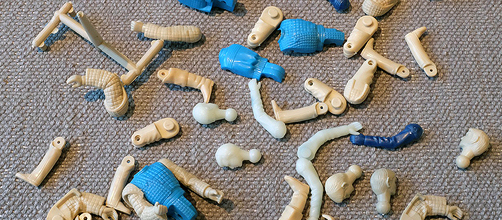 Multicolored test mold parts for the aborted Wesley Crusher and Romulan figures.
Multicolored test mold parts for the aborted Wesley Crusher and Romulan figures.
(Photo: Jim Fong)
Bob DiGiacomo: I was able to get to the Hong Kong area a few times, once for an international toy show. Sometimes I would go into one of the factories to see how things were being handled, which was kind of interesting, but it could make you a little crazy – most of the people working there had only very basic skills. I’d have to correct how they were doing something, and then turn around five minutes later and it was being done the wrong way again!
TrekCore: Let’s take a look at some of the figures that in that first-year lineup. One of the common collector questions deals with the four Data designs that were released, all with different paint jobs on the character’s face. Was this a manufacturing problem, or were there other reasons for the different color schemes?
Jim Fong: The issue was definitely not on the manufacturing side; it was that we were trying to nail down what his face should actually look like!
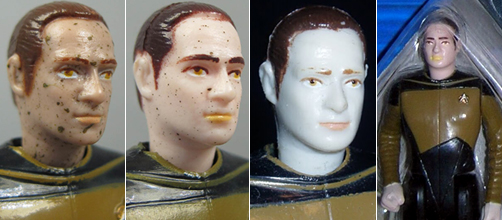 The many faces of Lieutenant Commander Data.
The many faces of Lieutenant Commander Data.
Of the different looks, I can’t remember which version went into production first – but I do remember being unhappy with the Data face paint, and requested that they change it to be more accurate with the character.
We tried several times to get the Hong Kong production team to correct the coloring, but when production is literally half a world away, it just turned into a bigger mess with each attempt. I’m still not happy with the way the figure turned out, and I’d do it all over if I had the chance.
TrekCore: The Q figure is an odd one. It’s missing the bright red judges’ robes worn by the character, but includes his red gloves, gold chains, and tall hat included. Was there any particular reason the robes weren’t part of the figure design?
Jim Fong: There may have been some minor poseability issues – I can’t remember for sure – but I know that if we had decided to mold in the red robe, we’d not only need more plastic, but it would also require an additional paint spray operation. Adding more resin and more paint would have impacted the landed price of the toy, so that’s probably why it wasn’t included.
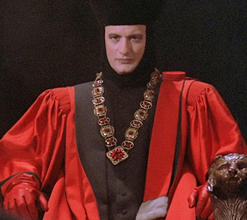 |
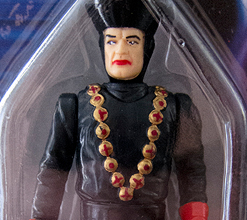 |
| ‘Judge Q’ and his plastic counterpart, without the bright red robes. | |
TrekCore: Galoob advertised Wesley Crusher and Romulan officer figures for the second year releases – which we’ll get into a bit later – rather than completing the main cast. Were there ever any plans to produce Beverly Crusher or Deanna Troi figures to fill out the Starfleet lineup?
Bob DiGiacomo: Historically, boys weren’t interested in buying female action figures. I mean, there were all the sexy girls from comic books boys would buy – Mattel had a big hit with She-Ra, and Galoob had a line called Golden Girls, but those lines were directed at girls – but because the girls didn’t really sell for us, we would never put them in as part of the first year releases.
Jim Fong: I can’t recall if we ever talked about doing Crusher or Troi – in fact, I can’t really remember why we did Tasha Yar and none of the other female characters. It may have been because Yar was head of security, and presumably that meant she would feature in more action sequences on the show.
Bob DiGiacomo: Tasha Yar was a kick-ass girl, so she was truly an ‘action’ figure – she was prominent in the show, she was tough…
Jim Fong: We had to take a guess which of the characters would be involved in more of the action scenes than others and our guess was that Wesley would be one of those characters. Had the line survived for more than its short run, I’m completely confident that we would have made figures of Dr. Crusher and Counselor Troi to go with the previously-released toys.
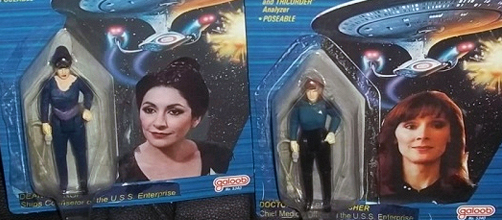 Fan-made Troi and Crusher figures, created using the Yar figure as a base.
Fan-made Troi and Crusher figures, created using the Yar figure as a base.
Bob DiGiacomo: Yes, if things continued, it would have been an obvious move to include the other women, along with different aliens and so forth. You would always look for different ways to extend the line – eventually, you’d put Character X into a different outfit, Picard in an alien costume, that sort of thing.
Jim Fong: Unfortunately, though, year two is when casualties usually hit a toy line. For the first year, we produced toys based on the limited information from the Paramount. If you look at the first year’s Next Generation toys, we didn’t just offer the Enterprise crew, but we also wanted to have aliens and villains to fill out the product line. We wanted to vary the figure offerings to that there would be more play value to the toys – humans vs. aliens; good guys vs. bad guys.
We needed this information nearly a year before the toys were released in the summer of 1988, but because Paramount only had a limited number of episodes to draw from when we got started, there was very little “bad guy” information available.
Like I said earlier, they were only up to production on “Encounter at Farpoint” when I visited the studio, which is why the Season One aliens (Q, the Ferengi, the Anticans, and the Selay) were all from the early part of the first season of the show.
By the time we began the Season Two line, we knew that the Romulans were going to become more active villains in the series, which is why they were designed for the second year of releases. We had to move a lot more cautiously with the second round of toys, though, because the Season One sales were soft.

